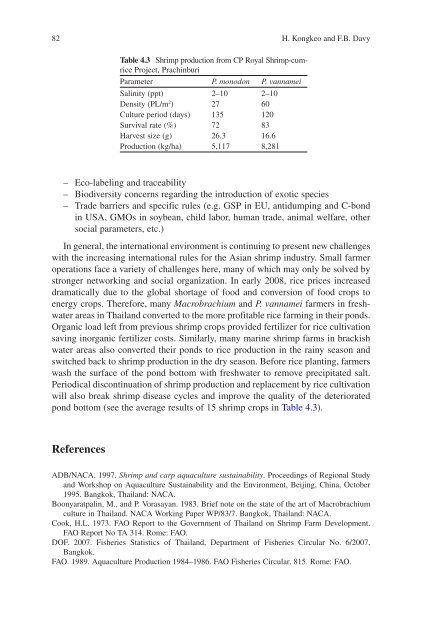Success Stories In Asian Aquaculture - Library - Network of ...
Success Stories In Asian Aquaculture - Library - Network of ...
Success Stories In Asian Aquaculture - Library - Network of ...
- No tags were found...
You also want an ePaper? Increase the reach of your titles
YUMPU automatically turns print PDFs into web optimized ePapers that Google loves.
82 H. Kongkeo and F.B. DavyTable 4.3 Shrimp production from CP Royal Shrimp-cumriceProject, PrachinburiParameter P. monodon P. vannameiSalinity (ppt) 2–10 2–102Density (PL/m ) 27 60Culture period (days) 135 120Survival rate (%) 72 83Harvest size (g) 26.3 16.6Production (kg/ha) 5,117 8,281– Eco-labeling and traceability– Biodiversity concerns regarding the introduction <strong>of</strong> exotic species– Trade barriers and specific rules (e.g. GSP in EU, antidumping and C-bondin USA, GMOs in soybean, child labor, human trade, animal welfare, othersocial parameters, etc.)<strong>In</strong> general, the international environment is continuing to present new challengeswith the increasing international rules for the <strong>Asian</strong> shrimp industry. Small farmeroperations face a variety <strong>of</strong> challenges here, many <strong>of</strong> which may only be solved bystronger networking and social organization. <strong>In</strong> early 2008, rice prices increaseddramatically due to the global shortage <strong>of</strong> food and conversion <strong>of</strong> food crops toenergy crops. Therefore, many Macrobrachium and P. vannamei farmers in freshwaterareas in Thailand converted to the more pr<strong>of</strong>itable rice farming in their ponds.Organic load left from previous shrimp crops provided fertilizer for rice cultivationsaving inorganic fertilizer costs. Similarly, many marine shrimp farms in brackishwater areas also converted their ponds to rice production in the rainy season andswitched back to shrimp production in the dry season. Before rice planting, farmerswash the surface <strong>of</strong> the pond bottom with freshwater to remove precipitated salt.Periodical discontinuation <strong>of</strong> shrimp production and replacement by rice cultivationwill also break shrimp disease cycles and improve the quality <strong>of</strong> the deterioratedpond bottom (see the average results <strong>of</strong> 15 shrimp crops in Table 4.3 ).ReferencesADB/NACA. 1997. Shrimp and carp aquaculture sustainability . Proceedings <strong>of</strong> Regional Studyand Workshop on <strong>Aquaculture</strong> Sustainability and the Environment, Beijing, China, October1995. Bangkok, Thailand: NACA.Boonyaratpalin, M., and P. Vorasayan. 1983. Brief note on the state <strong>of</strong> the art <strong>of</strong> Macrobrachiumculture in Thailand. NACA Working Paper WP/83/7. Bangkok, Thailand: NACA.Cook, H.L. 1973. FAO Report to the Government <strong>of</strong> Thailand on Shrimp Farm Development.FAO Report No TA 314. Rome: FAO.DOF. 2007. Fisheries Statistics <strong>of</strong> Thailand, Department <strong>of</strong> Fisheries Circular No. 6/2007,Bangkok.FAO. 1989. <strong>Aquaculture</strong> Production 1984–1986. FAO Fisheries Circular, 815. Rome: FAO.
















